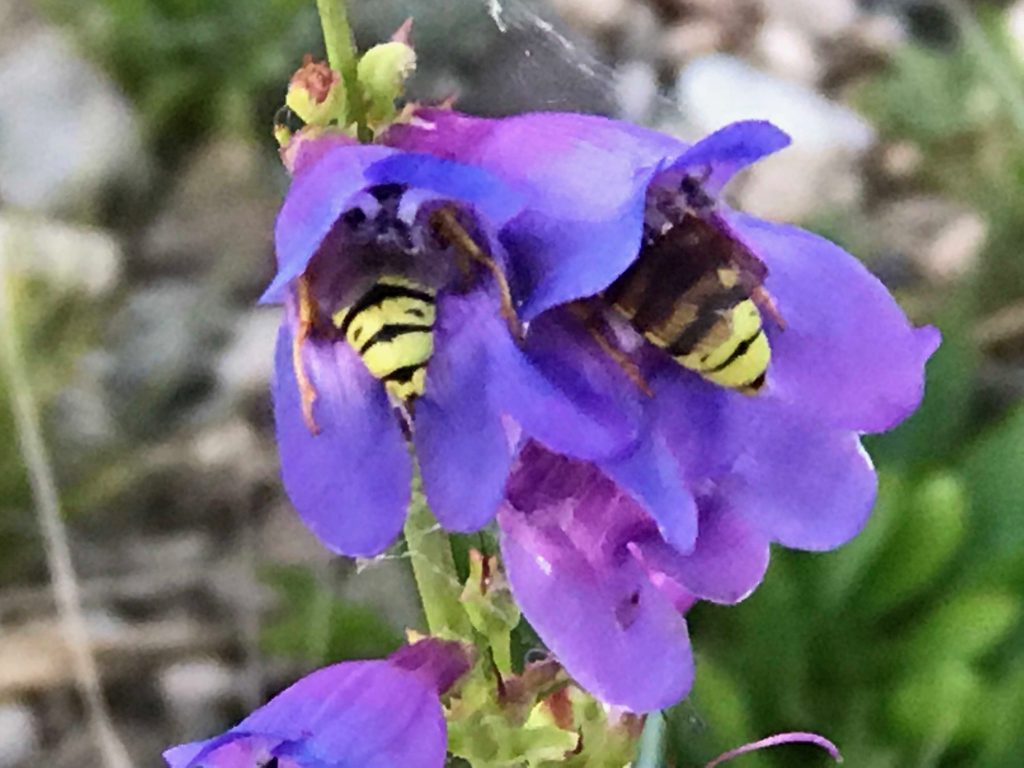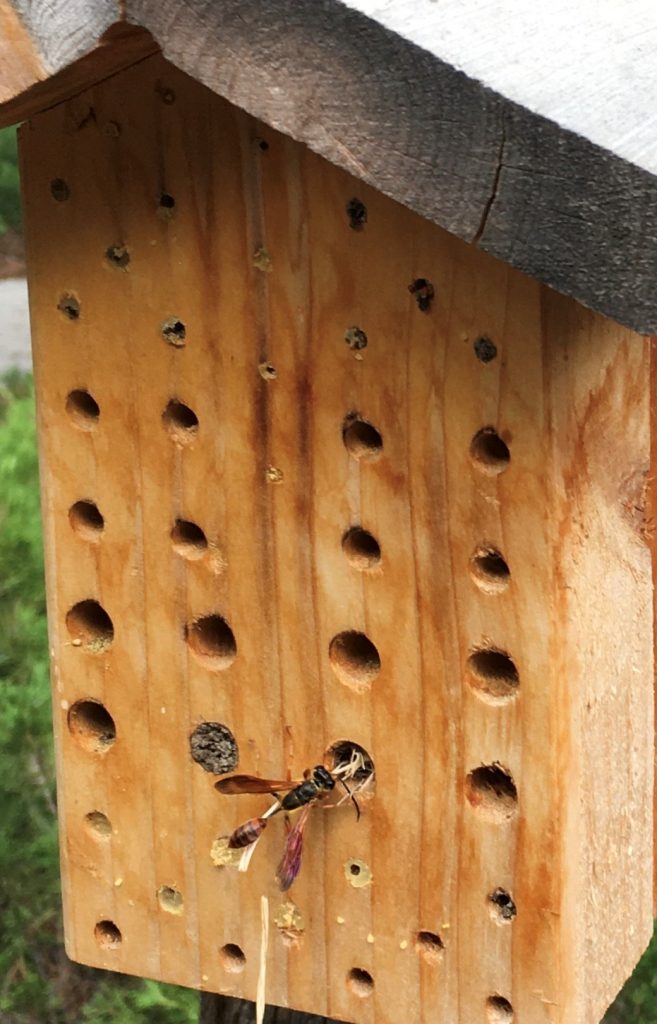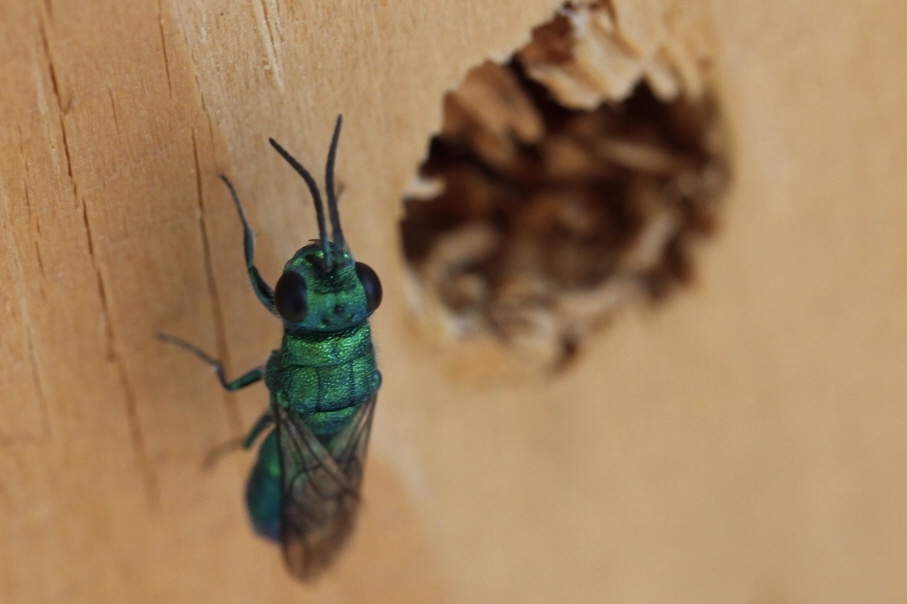All About Wasps – Part III – Solitary Hunting Wasps
- 2021-03-09
- By mkirk
- Posted in Uncategorized
By Lisa Mason, CSU Extension Horticulture Agent
Solitary Hunting Wasps
Solitary hunting wasps have a very different life cycle than social wasps. Their life cycle is like solitary bees. One of the differences between solitary wasps and bees is their food source. Female bees provide pollen and nectar provisions for their young. Solitary wasps are carnivores and provide caterpillars and other arthropod provisions for their young. Pollen wasps (subfamily Masarinae) are one exception to this rule. Pollen wasps provide pollen and nectar for their young. You can often observe them visiting Penstemon flowers. Most solitary wasps feed on arthropods, but sometimes you may see adult wasps feeding on flower nectar for energy.

Solitary wasps live independent lives. The females will build a nest in a variety of locations dependent on species. She may build a nest underground or in cavities. Some wasps like mud daubers (Families: Sphecidae or Crabronidae) will use mud to make small tubular nests in crevices. Throughout the summer, she will hunt and bring the prey back to her nest. She will provide enough for provisions in each nest cell for one wasp to grow to an adult. For instance, female spider wasps (Family: Pompilidae) will provide one spider for each larva. She paralyzes the spider and drags it to her underground nest. She will seal up the nest cell to prevent other scavengers from feeding on the spider. Wasps in the genus Trypoxylon will hunt immature spiders and collect between 5 and 20 spiders for each wasp larva. Other wasps will hunt other arthropods. Isodontia spp., also known as grass-carrying wasps, will hunt crickets for her young. She also collects blades of grass to line her nest cells.
Solitary wasps typically have a one-year life cycle. Some species of wasps may produce more than one generation a season. Once she finishes laying an egg in each of her nest cells, her life is complete. Her larvae will overwinter and pupate. They will emerge the following year. They will mate and their life cycles will repeat. Typically, male wasps do not play a huge role other than mating. Trypoxylon wasps are the exception. Males will often guard the nest entrance while females hunt and sometimes will clean out the nest cavities and bring the prey inside the nest after the female returns with the prey.
Should I be Afraid of Solitary Wasps?
Solitary wasps are not aggressive. They do not have a colony to defend, unlike social wasps. The females have the ability to sting, but they will only sting if you try to handle them or they are pressed up against your skin. Solitary wasps are often elusive, doing their job in our landscapes and gardens and providing us a valuable pest control service. Control is rarely needed.
Examples of Solitary Wasps in Your Garden
While the diversity of solitary wasps is too vast to cover, some examples you might observe in your garden include:
- Sand wasps (Bembicini tribe) are a group of wasps that nest in sandy areas. Sometimes they will nest in large aggregations. They feed on flies and other insects. You can often observe adults visiting flowers for nectar.
- Black and yellow mud daubers (Sceliphron caementarium) are a common solitary wasp seen in landscapes. The females create mud nests in crevices or other sheltered locations, often on the walls of buildings or houses. She could make 30-40 trips to collect mud for one nest cell! She paralyzes spiders and brings them back to the nest. Each nest cell may contain 6-15 paralyzed spiders.
- Leafhopper-hunting wasps (Pseneo punctatus) hunts and paralyzes leafhopper insects. The females build nests in cracks in the soil. Sometimes you may observe them nesting in between the cracks that form at the edge of potted plants.
- Tarantula hawks (Pepsis spp., Hemipepsis spp.) and other spider wasps (Pompilidae family) earn their name because they hunt spiders. Tarantula hawks specialize in hunting tarantula spiders. We have six species in Colorado, and they hunt tarantula spiders that occur here in the Aphonopelma genus. The spider is paralyzed by the wasp and taken to the underground burrow. The female lays one egg on each spider.
- Pemphredon wasps (Pemphredon spp.) nest in pithy stems such as roses (similar to small carpenter bees, Ceratina spp.) These wasps hunt aphids and will harvest approximately 24 aphids per nest cell.
- Beewolf wasps (Philanthus spp.) prey on bees and usually nest underground. While they do feed on bees, these wasps do not significantly and adversely impact bee populations. Urbanization and other challenges caused by humans have a much larger negative impacts on bee populations.
Why are Wasps Nesting in My Bee Hotel? Just like solitary bees, solitary wasps are looking for cavities to nest in. They make take up residence in your bee hotel. No need to be alarmed! Solitary wasps are docile and beneficial to our garden and the ecosystem. They will co-exist with the other bees and wasps nesting in your bee hotel. Since the bees and wasps nesting in your bee hotel are docile, you can take the opportunity to watch their activity. You can watch the wasps and bees bring back nesting material and work hard at providing provisions for their young. Remember: Bee hotels need to be maintained to prevent molds, fungus, pests, and pathogens from harming the beneficial insects. Check out the Extension fact sheets from Michigan and Nebraska for more information.
Common wasps you may observe nesting in your bee hotel include:
- Potter wasps (Ancistrocerus and Euodynerus spp.) will make their nests out of mud and provide their young with caterpillars or beetle larvae.
- Aphid wasps (Passaloecus spp.) will make their nest with pine resin and bring aphids to the nest.
- Grass-carrying wasps (Isodontia spp.) will line their nest with blades of grass and hunt crickets.
- Spider wasps (Pompilidae family) will mostly nest underground with a few exceptions that may nest in cavities. They make the nest with mud and will hunt one spider per nest cell.
- Cuckoo wasps (Chrysididae family and others) will parasitize the solitary wasps. The cuckoo wasp larvae will outcompete the host wasp. Some species are a bright emerald green!
Horticulture Resources
- Garden Buzz Archives
- CSU Extension Resources
- Colorado Master Gardener Program
- Foothills to Plains Native Plant Master Program
- Native Bee Watch Community Science Program
- The Co-Hort Blog
- PlantTalk Colorado
- Soil Testing
- Plant Select
- Emerald Ash Borer
- Japanese Beetle
- Colorado State Forest Service
- Ask an Expert






